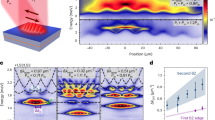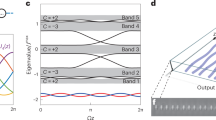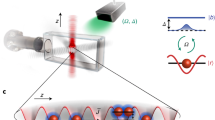Abstract
Exciton-polaritons are hybrid light–matter quasiparticles formed by strongly interacting photons and excitons (electron–hole pairs) in semiconductor microcavities1,2,3. They have emerged as a robust solid-state platform for next-generation optoelectronic applications as well as for fundamental studies of quantum many-body physics. Importantly, exciton-polaritons are a profoundly open (that is, non-Hermitian4,5) quantum system, which requires constant pumping of energy and continuously decays, releasing coherent radiation6. Thus, the exciton-polaritons always exist in a balanced potential landscape of gain and loss. However, the inherent non-Hermitian nature of this potential has so far been largely ignored in exciton-polariton physics. Here we demonstrate that non-Hermiticity dramatically modifies the structure of modes and spectral degeneracies in exciton-polariton systems, and, therefore, will affect their quantum transport, localization and dynamical properties7,8,9. Using a spatially structured optical pump10,11,12, we create a chaotic exciton-polariton billiard—a two-dimensional area enclosed by a curved potential barrier. Eigenmodes of this billiard exhibit multiple non-Hermitian spectral degeneracies, known as exceptional points13,14. Such points can cause remarkable wave phenomena, such as unidirectional transport15, anomalous lasing/absorption16,17 and chiral modes18. By varying parameters of the billiard, we observe crossing and anti-crossing of energy levels and reveal the non-trivial topological modal structure exclusive to non-Hermitian systems9,13,14,15,16,17,18,19,20,21,22. We also observe mode switching and a topological Berry phase for a parameter loop encircling the exceptional point23,24. Our findings pave the way to studies of non-Hermitian quantum dynamics of exciton-polaritons, which may uncover novel operating principles for polariton-based devices.
This is a preview of subscription content, access via your institution
Access options
Subscribe to this journal
Receive 51 print issues and online access
$199.00 per year
only $3.90 per issue
Buy this article
- Purchase on Springer Link
- Instant access to full article PDF
Prices may be subject to local taxes which are calculated during checkout




Similar content being viewed by others
References
Kasprzak, J. et al. Bose–Einstein condensation of exciton polaritons. Nature 443, 409–414 (2006)
Deng, H., Haug, H. & Yamamoto, Y. Exciton-polariton Bose–Einstein condensation. Rev. Mod. Phys. 82, 1489–1537 (2010)
Carusotto, I. & Ciuti, C. Quantum fluids of light. Rev. Mod. Phys. 85, 299–366 (2013)
Moiseyev, N. Non-Hermitian Quantum Mechanics (Cambridge Univ. Press, 2011)
Bender, C. M. Making sense of non-Hermitian Hamiltonians. Rep. Prog. Phys. 70, 947–1018 (2007)
Savvidis, P. G. et al. Off-branch polaritons and multiple scattering in semiconductor microcavities. Phys. Rev. B 64, 075311 (2001)
Berry, M. V. Quantizing a classically ergodic system: Sinai’s billiard and the KKR method. Ann. Phys. 131, 163–216 (1981)
Guhr, T., Müller-Groeling, A. & Weidenmüller, H. A. Random-matrix theories in quantum physics: common concepts. Phys. Rep. 299, 189–425 (1998)
Bliokh, K. Y., Bliokh, Y. P., Freilikher, V., Genack, A. Z. & Sebbah, P. Coupling and level repulsion in the localized regime: from isolated to quasiextended modes. Phys. Rev. Lett. 101, 133901 (2008)
Tosi, G. et al. Sculpting oscillators with light within a nonlinear quantum fluid. Nature Phys. 8, 190–194 (2012)
Sanvitto, D. et al. All-optical control of the quantum flow of a polariton condensate. Nature Photon. 5, 610–614 (2011)
Dall, R. et al. Creation of orbital angular momentum states with chiral polaritonic lenses. Phys. Rev. Lett. 113, 200404 (2014)
Berry, M. V. Physics of non-Hermitian degeneracies. Czech. J. Phys. 54, 1039–1047 (2004)
Heiss, W. D. The physics of exceptional points. J. Phys. Math. Gen. 45, 444016 (2012)
Guo, A. et al. Observation of PT-symmetry breaking in complex optical potentials. Phys. Rev. Lett. 103, 093902 (2009)
Peng, B. et al. Loss-induced suppression and revival of lasing. Science 346, 328–332 (2014)
Sun, Y., Tan, W., Li, H.-Q., Li, J. & Chen, H. Experimental demonstration of a coherent perfect absorber with PT phase transition. Phys. Rev. Lett. 112, 143903 (2014)
Dembowski, C. et al. Observation of a chiral state in a microwave cavity. Phys. Rev. Lett. 90, 034101 (2003)
Cao, H. & Wiersig, J. Dielectric microcavities: model systems for wave chaos and non-Hermitian physics. Rev. Mod. Phys. 87, 61–111 (2015)
Dembowski, C. et al. Experimental observation of the topological structure of exceptional points. Phys. Rev. Lett. 86, 787–790 (2001)
Lee, S.-B. et al. Observation of an exceptional point in a chaotic optical microcavity. Phys. Rev. Lett. 103, 134101 (2009)
Choi, Y. et al. Quasi-eigenstate coalescence in an atomic-cavity quantum composite. Phys. Rev. Lett. 104, 153601 (2010)
Heiss, W. D. Phases of wave functions and level repulsion. Eur. Phys. J. D 7, 1–4 (1999)
Dembowski, C. et al. Encircling an exceptional point. Phys. Rev. E 69, 056216 (2004)
Akis, R., Ferry, D. K. & Bird, J. P. Wave function scarring effects in open stadium shaped quantum dots. Phys. Rev. Lett. 79, 123–126 (1997)
Milner, V., Hanssen, J. L., Campbell, W. C. & Raizen, M. G. Optical billiards for atoms. Phys. Rev. Lett. 86, 1514–1517 (2001)
Kaplan, A., Friedman, N., Anderson, M. & Davidson, N. Observation of islands of stability in soft wall atom-optics billiards. Phys. Rev. Lett. 87, 274101 (2001)
Ponomarenko, L. A. et al. Chaotic Dirac billiard in graphene quantum dots. Science 320, 356–358 (2008)
Uzdin, R., Mailybaev, A. & Moiseyev, N. On the observability and asymmetry of adiabatic state flips generated by exceptional points. J. Phys. A 44, 435302 (2011)
Berry, M. V. & Uzdin, R. Slow non-Hermitian cycling: exact solutions and the Stokes phenomenon. J. Phys. A 44, 435303 (2011)
Kavokin, A., Baumberg, J., Malpuech, G. & Laussy, F. Microcavities (Oxford Univ. Press, 2007)
Sinai, Y. G. Dynamical systems with elastic reflections. Russ. Math. Surv. 25, 137–189 (1970)
Keeling, J. & Berloff, N. G. Spontaneous rotating vortex lattices in a pumped decaying condensate. Phys. Rev. Lett. 100, 250401 (2008)
Cristofolini, P. et al. Optical superfluid phase transitions and trapping of polariton condensates. Phys. Rev. Lett. 110, 186403 (2013)
Askitopoulos, A. et al. A robust platform for engineering pure-quantum-state transitions in polariton condensates. Phys. Rev. B 92, 035305 (2015)
Wouters, M. & Carusotto, I. Excitations in a nonequilibrium Bose–Einstein condensate of exciton polaritons. Phys. Rev. Lett. 99, 140402 (2007)
Smirnov, L. A., Smirnova, D. A., Ostrovskaya, E. A. & Kivshar, Yu. S. Dynamics and stability of dark solitons in exciton-polariton condensates. Phys. Rev. B 89, 235310 (2014)
Wouters, M. Energy relaxation in the mean-field description of polariton condensates. New J. Phys. 14, 075020 (2012)
Wertz, E. et al. Propagation and amplification dynamics of 1D polariton condensates. Phys. Rev. Lett. 109, 216404 (2012)
Eastham, P. R. Mode locking and mode competition in a nonequilibrium solid-state condensate. Phys. Rev. B 78, 035319 (2008)
Ge, L. & Stone, A. D. Parity-time symmetry breaking beyond one dimension: the role of degeneracy. Phys. Rev. X 4, 031011 (2014)
Acknowledgements
We thank M. Berry and O. Kirillov for comments. This research was supported by the Australian Research Council, the ImPACT Program of the Council for Science, Technology and Innovation (Cabinet Office, Government of Japan), the RIKEN iTHES Project, the MURI Center for Dynamic Magneto-Optics, a Grant-in-Aid for Scientific Research (type A), and the State of Bavaria.
Author information
Authors and Affiliations
Contributions
E.A.O., T.G., E.E. and K.Y.B. conceived the idea for this research; T.G., E.E., M.D.F., R.G.D. and A.G.T. designed and built the experiment with conceptual contributions from E.A.O.; T.G., E.E. and R.G.D. collected and analysed experimental data; K.Y.B, E.E., T.C.H.L. and E.A.O. performed theoretical and numerical analysis; S.B., M.K., C.S. and S.H. fabricated and characterized the semiconductor microcavity; E.A.O. and K.Y.B. wrote the paper with input from T.G., E.E. and T.C.H.L.; F.N., M.D.F., A.G.T, S.H., Y.Y. and Y.S.K. contributed to discussions and the shaping of the manuscript.
Corresponding author
Ethics declarations
Competing interests
The authors declare no competing financial interests.
Extended data figures and tables
Extended Data Figure 1 Diagram of the experimental apparatus.
See Methods for details.
Extended Data Figure 2 Schematics of the optically induced billiard potential with two different wall thicknesses.
a, Thin walls; b, thick walls. The active regions corresponding to the optical pump are shown in black, and we note that the enclosed area does not change with wall thickness.
Extended Data Figure 3 Effect of wall thickness on spectroscopic line profiles of the Sinai billiard.
a, b, Profiles are shown in the vicinity of the degeneracy for the levels highlighted in Fig. 1c, d with thick (a) and thin (b) walls. The thick lines demonstrate the principle of data extraction for anti-crossing (a) and crossing (b) of the energy levels corresponding to those shown in Fig. 2a and b, respectively
Extended Data Figure 4 Spatial density distribution of the first seven simultaneously populated lowest-energy modes of the Sinai billiard.
Spatial density distributions were obtained from the thick-wall setup (Extended Data Fig. 2b) with R/W = 0.35. Top row, experimentally imaged; middle row, calculated using the effective linear potential model; bottom row, calculated using the full dynamical model given by equation (2).
Extended Data Figure 5 Spatial modes in the hybridization regions.
a–g, Calculated spatial modes; each panel shows the modulus squared of the wavefunction (left) and the wavefunction’s phase distribution (right, colour coded). a, b, e, f, Numerically calculated pure spatial eigenstates (modes 3 (a, e) and 4 (b, f)) for the Sinai billiard with thick and thin walls in the corresponding hybridization regions shown in Fig. 2a and b, respectively. c, d, g, The superpositions of modes 3 and 4 that match the experimentally imaged modes shown in Fig. 2; c (boxed in blue) and d (boxed in red) correspond to the blue and red curves of Fig. 2a, respectively, while g (boxed in red and blue) corresponds to the crossing point in Fig. 2b. The relative populations of pure modes in the superposition states are: c, |α|2 = 0.85 and |β|2 = 0.15; d, |α|2 = 0.65 and |β|2 = 0.35; g, |α|2 = 0.60 and |β|2 = 0.40.
Rights and permissions
About this article
Cite this article
Gao, T., Estrecho, E., Bliokh, K. et al. Observation of non-Hermitian degeneracies in a chaotic exciton-polariton billiard. Nature 526, 554–558 (2015). https://doi.org/10.1038/nature15522
Received:
Accepted:
Published:
Issue Date:
DOI: https://doi.org/10.1038/nature15522
This article is cited by
-
Non-orthogonal cavity modes near exceptional points in the far field
Communications Physics (2024)
-
Creating pairs of exceptional points for arbitrary polarization control: asymmetric vectorial wavefront modulation
Nature Communications (2024)
-
Detecting bulk and edge exceptional points in non-Hermitian systems through generalized Petermann factors
Frontiers of Physics (2024)
-
Symmetry-protected topological exceptional chains in non-Hermitian crystals
Communications Physics (2023)
-
Exceptional points and non-Hermitian photonics at the nanoscale
Nature Nanotechnology (2023)
Comments
By submitting a comment you agree to abide by our Terms and Community Guidelines. If you find something abusive or that does not comply with our terms or guidelines please flag it as inappropriate.



